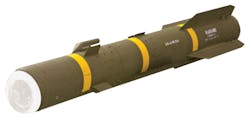Lockheed Martin to build JAGM air-to-ground missile with multimode seeker for Army UAVs and helicopters
REDSTONE ARSENAL, Ala. – Missile experts at Lockheed Martin Corp. will build advanced air-to-ground missiles for unmanned aerial vehicles (UAVs) and manned attack helicopters under terms of a $13.5 million order announced Friday.
Officials of the Army Contracting Command at Redstone Arsenal, Ala., are asking the Lockheed Martin Missiles and Fire Control segment in Orlando, Fla., to build Joint-Air-to-Ground Missile (JAGM) systems, which will replace U.S. Army and Navy inventories of Airborne TOW, Maverick, and Hellfire air-to-ground missiles.
Lockheed Martin is developing the JAGM for launch from the Army AH-64 Apache attack helicopter, the Army MQ-1C Gray Eagle unmanned aerial vehicle (UAV), the Navy MH-60R helicopter, and the Marine Corps AH-1Z Viper attack helicopter.
The Lockheed Martin JAGM has a multi-mode guidance section with semi-active laser (SAL) sensor for precision-strike and a fire-and-forget millimeter wave (MMW) radar for moving targets in all-weather conditions. The small missile is nearly six feet long, seven inches in diameter, and weighs 108 pounds.
JAGM can engage several different stationary and moving targets in the bad weather, smoke and dust, and advanced countermeasures. Laser and radar guided engagement modes enable JAGM to strike accurately and reduce collateral damage, Lockheed Martin officials say.
JAGM’s targets include moving and stationary armored combat vehicles; air defense units; patrol craft; artillery; missile launchers; radar sites; command-and-control nodes; bunkers; and other structures in urban and complex terrain.
The modular and low-risk JAGM design includes the Lockheed Martin AGM-114 Hellfire missile body and the new multi-mode seeker. The JAGM guidance section blends semi-active laser guidance and millimeter wave radar to guide the new missile to its target. Future improvements may include an uncooled infrared sensor in a new tri-mode seeker.
On this order Lockheed Martin will do the work in Orlando, Fla., and should be finished by September 2024. For more information contact Lockheed Martin Missiles and Fire Control online at www.lockheedmartin.com, or the Army Contracting Command-Redstone at www.acc.army.mil/contractingcenters/acc-rsa.

